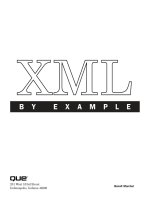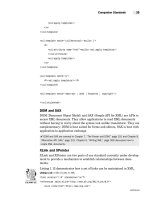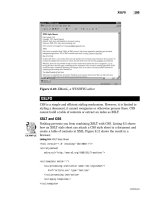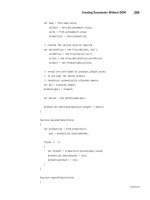Tài liệu XML by Example- P8 pdf
Bạn đang xem bản rút gọn của tài liệu. Xem và tải ngay bản đầy đủ của tài liệu tại đây (392.43 KB, 50 trang )
Similarly, you need to easily recognize high-level structures. In the follow-
ing document, it is easy to recognize that there is a name, an address, and
a phone number.
John Doe
34 Fountain Square Plaza
Cincinnati, OH 45202
US
513-555-8889
This structure results in the following markup:
<entry>
<name>John Doe</name>
<address>34 Fountain Square Plaza
Cincinnati, OH 45202
US</address>
<tel>513-555-8889</tel>
</entry>
The difficulty is finding the appropriate granularity. Is the previous exam-
ple enough? Unlikely. It is probably best to mark more. For example:
<entry>
<name>John Doe</name>
<address>
<street>34 Fountain Square Plaza</street>
<region>OH</region>
<postal-code>45202</postal-code>
<locality>Cincinnati</locality>
<country>US</country>
</address>
<tel>513-555-8889</tel>
</entry>
Is this enough or do you need to further break some of the elements,
such as
<name>
<fname>John</fname>
<lname>Doe</lname>
</name>
335
The Right Level of Abstraction
12 2429 CH10 2.29.2000 2:24 PM Page 335
Please purchase PDF Split-Merge on www.verypdf.com to remove this watermark.
The question is: “Where do you stop?” What is the correct granularity for an
XML document? Unfortunately, there are no strict criteria. Your experience
will guide you. It is, however, a good idea to mark up as much as is conve-
nient.
The end user’s convenience is the best guideline to use when deciding
where to stop breaking a document into smaller pieces.
Indeed, if the DTD is too detailed and requires the user to identify details,
it won’t work. The document may be highly structured but, upon closer
analysis, most of the markup will prove to be incorrect. This problem is
often experienced by database administrators who have very good data
schemas but very poor information in the database.
For example, if you were to ask users to break the street into further com-
ponents such as
<street>
<nr>34</nr>
<name>Fountain Square</name>
<type>Plaza</type>
</street>
It probably wouldn’t work. Realistically, few people would know where to
insert the markup. Is it
<type>Plaza</type>
or
<street>
<nr>34</nr>
<name>Fountain</name>
<type>Square Plaza</type>
</street>
The only way to know when to stop breaking a document into smaller
pieces is to write sample documents or even small prototypes as you design
the DTD. As you gain experience with XML, this will become easier.
Use the sample documents or the prototype to test the usability of the DTD.
Does it accurately capture all the information? Does it capture enough
details? Is it nonobtrusive? You don’t want to capture too many details and
alienate the users.
Avoiding Too Many Options
As you finalize your DTD, you should proofread it to check against exces-
sive use of options.
A warning bell should ring in your head if the DTD leaves too many options
open. This is usually a sign that you need to be stricter in the markup.
336
Chapter 10: Modeling for Flexibility
12 2429 CH10 2.29.2000 2:24 PM Page 336
Please purchase PDF Split-Merge on www.verypdf.com to remove this watermark.
The DTD in Listing 10.21 leaves too many options open. Figure 10.8 is a
graphical view of the DTD.
337
The Right Level of Abstraction
EXAMPLE
Figure 10.8: A graphical view of the DTD
Listing 10.21: A DTD for an Order
<!ENTITY % company “(name,address)”>
<!ELEMENT order (date,sender,receiver,lines)>
<!ELEMENT date (#PCDATA)>
<!ELEMENT sender %company;>
<!ELEMENT receiver %company;>
<!ELEMENT lines (reference*,description*,quantity?,
time-material*,price?)+>
<!ELEMENT reference EMPTY>
<!ATTLIST reference href CDATA #IMPLIED>
<!ELEMENT description (#PCDATA)>
<!ELEMENT quantity (#PCDATA)>
<!ELEMENT time-material (#PCDATA)>
<!ELEMENT price (#PCDATA)>
<!ATTLIST price currency (usd | eur) #IMPLIED>
<!ELEMENT name (#PCDATA)>
<!ELEMENT address (street,region?,postal-code,
locality,country)>
<!ELEMENT street (#PCDATA)>
<!ELEMENT region (#PCDATA)>
<!ELEMENT postal-code (#PCDATA)>
<!ELEMENT locality (#PCDATA)>
<!ELEMENT country (#PCDATA)>
The problem with this DTD is the content model for
lines
:
12 2429 CH10 2.29.2000 2:24 PM Page 337
Please purchase PDF Split-Merge on www.verypdf.com to remove this watermark.
<!ELEMENT lines (reference*,description*,quantity?,
time-material*,price?)+>
This model has so many options that the document in Listing 10.22 is valid,
even though the
lines
element has no content. This is probably not what
the DTD designer intended because it makes no sense to issue an order
that contains only names and addresses.
Listing 10.22: A Valid Invoice
<?xml version=”1.0” encoding=”ISO-8859-1”?>
<!DOCTYPE order SYSTEM “order.dtd”>
<order>
<date>19990727</date>
<sender>
<name>Playfield Software</name>
<address>
<street>38 Fountain Square Plaza</street>
<region>OH</region>
<postal-code>45263</postal-code>
<locality>Cincinnati</locality>
<country>US</country>
</address>
</sender>
<receiver>
<name>Macmillan Publishing</name>
<address>
<street>201 West 103
rd
Street</street>
<region>IN</region>
<postal-code>46290</postal-code>
<locality>Indianapolis</locality>
<country>US</country>
</address>
</receiver>
<lines/>
</order>
This creates a hole in the document. The solution is to use the
or
connector
more often. A more realistic content model might be
<!ELEMENT lines ((reference | description)+,
(quantity | time-material+),price?)+>
338
Chapter 10: Modeling for Flexibility
12 2429 CH10 2.29.2000 2:24 PM Page 338
Please purchase PDF Split-Merge on www.verypdf.com to remove this watermark.
This model states that there is at least one reference or one description for
each product (there may be several references or several descriptions).
Also the order is either for a certain quantity or on a time and material
basis, one of the two elements must be present. Figure 10.9 illustrates this
structure.
339
Attributes Versus Elements
Figure 10.9: The structure of the new DTD
When resolving these problems, it is important to avoid introducing ambi-
guities in the DTD. The following model would have been ambiguous:
<!ELEMENT lines ((reference+ | (reference+, description+) |
description+),
(quantity | time-material+),price?)+>
It says that a line has either references or descriptions or both. Unfor-
tunately, it is ambiguous. To remove the ambiguity, you can introduce a
new element such as
<!ELEMENT line ((ref-desc | reference+ | description+),
(quantity | time-material+ | price?))+>
<!ELEMENT ref-desc (reference+,description+)>
Attributes Versus Elements
As you have seen in the earlier section “The Right Level of Abstraction,”
you can use elements or attributes interchangeably to record the informa-
tion in a DTD.
This has lead to heated debates in the XML community between the propo-
nents of attributes and the proponents of elements. Specifically, the debate
is whether it is best to store content in attributes or in elements.
Both sides have very convincing arguments and support their claims with
good examples that clearly demonstrate the superiority of attributes over
elements, or elements over attributes. The only problem is that both sides
are right.
12 2429 CH10 2.29.2000 2:24 PM Page 339
Please purchase PDF Split-Merge on www.verypdf.com to remove this watermark.
This debate is similar to the debate between inheritance and aggregation in
object-oriented modeling. There are some clear arguments for and against
each approach. And yet, when you have a blank sheet of paper in front of
you, the solution is sometimes obvious, sometimes not.
I don’t believe one approach is intrinsically better than the other. I try to
keep an open mind and to adapt to the needs of the application at hand.
For some applications, attributes just seem to work better, for others, ele-
ments are the clear winner. I always keep in mind that conversion is an
option provided the structure is good enough.
Your experience will guide you as well. The next two sections present some
of the reasons you might use attributes or elements.
Using Attributes
1. A major advantage of attributes is that they establish a strong rela-
tionship with their parent element. This makes it easy to process all
the attributes attached to an element. This is particularly true for
SAX parsers, as illustrated by the following code excerpt:
public void startElement(String name,AttributeList attributes)
{
if(name.equals(“price”))
{
String attribute = attributes.getValue(“price”);
if(null != attribute)
{
double price = toDouble(attribute);
if(min > price)
{
min = price;
vendor = attributes.getValue(“vendor”);
}
}
}
}
In contrast, it is more difficult to walk down the element tree and collect
information from the children of an element.
2. Elements are naturally organized in a hierarchy, whereas attributes
cannot nest.
340
Chapter 10: Modeling for Flexibility
EXAMPLE
EXAMPLE
12 2429 CH10 2.29.2000 2:24 PM Page 340
Please purchase PDF Split-Merge on www.verypdf.com to remove this watermark.
This provides a clean-cut separation between elements and attributes that
has led some to argue that elements should be used to express the struc-
ture (the relationship between elements) and attributes to hold the content.
This approach suggests that leaf elements should be turned into attributes:
<entry>
<name name=”John Doe”/>
<address street=”34 Fountain Square Plaza”
region=”OH”
postal-code=”45202”
locality=”Cincinnati”
country=”US”/>
<tel tel=”513-555-8889”/>
</entry>
3. Finally, attributes are also popular because the DTD gives you more
control over the type and value of attributes than over the type and
value of elements.
You can restrict an attribute to a list of values whereas the type of an ele-
ment is essentially text.
<!ATTLIST price currency (usd | eur) #IMPLIED>
This argument however will soon disappear. The new XML schema will
offer better data typing for elements.
Using Elements
1. If attributes are easier to manipulate for the programmer, elements
are typically easier to work with in XML editors or browsers. For one
thing, it is impossible to display attributes with CSS.
This would suggest that attributes are great for abstract data and elements
are ideal for human data.
url[protocol=’mailto’] {
text-decoration: none;
}
2. Elements can be repeated through the
+
and
*
occurrence indicators;
attributes cannot.
<?xml version=”1.0”?>
<entry>
<name>John Doe</name>
341
Attributes Versus Elements
EXAMPLE
EXAMPLE
EXAMPLE
12 2429 CH10 2.29.2000 2:24 PM Page 341
Please purchase PDF Split-Merge on www.verypdf.com to remove this watermark.
<tel preferred=”true”>513-555-8889</tel>
<tel>513-555-7098</tel>
</entry>
3. Generally speaking, elements offer more room for extension and reuse
than attributes because elements are highly structured.
For example, in Listing 10.22, the
address
element is reused in the
sender
and
receiver
elements. It is reused with its complete structure.
Lessons Learned
It is clear that elements and attributes have different characteristics.
Unfortunately, nobody seems to agree on how to exploit them best.
Over time, you will develop your own set of rules of when to use an
attribute and when to use an element. My set of rules, as I have already
explained, is to use elements for the essential property of an object and
attributes for ancillary properties.
This rule reflects my emphasis on structure over content. It is also very
similar to the popular rule that originated in the SGML community that
suggests using attributes for abstract concepts and elements for concrete
ones.
Note that this is not a hard rule but one that depends on the application
being considered. For example, in the price-comparison application, the cur-
rency is second in importance to the price:
<price currency=”usd”>499.00</price>
However in a financial application, the currency may be an element in its
own right:
<currency>usd</currency>
TIP
Gray areas like this, where there are no clear rules, are unavoidable in XML. XML
wouldn’t be so powerful and flexible if it didn’t offer several solutions for each problem.
Don’t waste too much time trying to find the best rule because there probably is no one
best rule. Pick one approach, document it in as nonambiguous terms as possible, and
try to be consistent.
342
Chapter 10: Modeling for Flexibility
EXAMPLE
EXAMPLE
12 2429 CH10 2.29.2000 2:24 PM Page 342
Please purchase PDF Split-Merge on www.verypdf.com to remove this watermark.
What’s Next
The next two chapters put all the knowledge of XML you have acquired to
the test because they help you build a realistic e-commerce application
based on XML.
The application demonstrates many of the techniques you have studied in a
real-life context. It also shows how to use XML for distributed applications.
343
What's Next
12 2429 CH10 2.29.2000 2:24 PM Page 343
Please purchase PDF Split-Merge on www.verypdf.com to remove this watermark.
13 2429 CH11 2.29.2000 2:24 PM Page 344
Please purchase PDF Split-Merge on www.verypdf.com to remove this watermark.
11
N-Tiered Architecture and XML
You are now familiar with every aspect of XML. This chapter and the next
one demonstrate how to put these techniques to use in a medium-sized
example. There are no new techniques introduced in these chapters, but
they illustrate how to apply what you have learned to a real-world applica-
tion. In particular, you learn
• how to use XML for interapplication communication
• how to use XML for electronic commerce
• how to take advantage of XML tools
Throughout these two chapters, you’ll develop a multimerchant Web shop
or a Web mall, dubbed XCommerce (XML Commerce), as an example.
This chapter must be read in conjunction with the next chapter. This chap-
ter introduces many of the ideas underlying the XCommerce application. It
includes many code snippets and partial listings that are used to illustrate
a point. The complete source code is in the next chapter. The concept of an
electronic mall is increasingly popular; the largest sites such as Yahoo! and
AOL are rushing to offer such services. The idea is to group several mer-
chants on one Web site. The mall offers additional services, such as a single
shopping cart, joint promotion, and, hopefully, more traffic.
However, a mall implementation needs to balance the need for common fea-
tures among the various merchants, such as a shopping cart, with the need
for the merchants to differentiate themselves and their products. XML
helps in this respect.
What Is an N-Tiered Application?
Most medium- and large-scale XML applications are distributed applica-
tions, meaning that they involve several computers linked over a network
(typically the Internet or a LAN).
13 2429 CH11 2.29.2000 2:24 PM Page 345
Please purchase PDF Split-Merge on www.verypdf.com to remove this watermark.
Most of these applications are called n-tiered applications. XCommerce is
an n-tier application. Essentially, n-tiered applications are a specialized
form of client/server application.
Client/Server Applications
As Figure 11.1 illustrates, the Web is a good example of a client/server
application, so you are already familiar with the idea. On the left side is the
Web client also known as the browser. On the right side is the Web server.
346
Chapter 11: N-Tiered Architecture and XML
EXAMPLE
Figure 11.1: The Web is a client/server application.
At the user initiative, the browser requests Web pages from the server. The
server delivers the pages and the client displays them. In effect, the client
is a tool for the user to interact with the server.
Client/server applications have two essential characteristics:
• They are distributed applications, meaning that two or more comput-
ers are connected over a network.
• The two computers have specific roles.
The second point differentiates client/server applications from other forms
of distributed applications (such as peer-to-peer ones). It means that there
is a client and server and that their roles differ.
The server provides services to the client. The server is the producer and
the client is the consumer. However, the server provides services only at the
client’s request. This is a sort of master/slave relationship where the master
(the client) requests services from the slave (the server).
The Web is but one example of client/server. Other examples include
• Internet mail, where the mail client (such as Eudora or Outlook) inter-
acts with the mail server to deliver and receive email
• Novell print and file servers, where the stations on a LAN can store
files or print documents on a server
• PowerBuilder and other 4GL applications, where a local client inter-
acts with a database server for administrative applications
EXAMPLE
13 2429 CH11 2.29.2000 2:24 PM Page 346
Please purchase PDF Split-Merge on www.verypdf.com to remove this watermark.
Generally speaking, the server has access to resources that the client does
not have access to or that are too difficult for the client to manage. In the
case of the Web, the resources are HTML files. It would not be realistic to
keep a local copy of every Web page. It makes more sense to request those
pages you want to see at a particular time.
For email, the resource is a 24/7 Internet connection. A client could send
emails directly but it makes more sense to pass the burden to a dedicated
server that handles errors and retries.
Novell servers have printers and plenty of hard disks. In most setups, it is
not cost-effective to give every user a fast printer and it is safer and more
efficient to store files on a central location. Among other things, it simplifies
backups.
Database servers provide a central storage for the data in the organization.
Therefore, a database server has more information than is available to a
given PC.
3-Tiered Applications
As we enter an increasingly wired world, the server itself needs to rely
on other servers. Webmail is a good example of an n-tiered application.
Webmail are those applications that let you read and compose emails
through a Web site. Popular Webmails include Hotmail (
www.hotmail.com
)
and Startmail (
www.startmail.com
).
As Figure 11.2 illustrates, in this setup, a server can also act as a client to
another server. Indeed, the browser is a client. The email server is a server.
But the Web server is both a client and a server: It is a server when talking
to the browser and it is a client when talking to the email server.
347
What Is an N-Tiered Application?
EXAMPLE
Figure 11.2: The Web server plays both roles.
This application consists of two client/server applications chained together.
This is known as a three-tiered application. There are three tiers because
there are three parties involved.
To differentiate between the various clients and servers, the leftmost client
is often called the presentation tier because it is the interface for the end
user. The machine in the middle, the one that plays both client and server,
is often referred to as a middle tier.
13 2429 CH11 2.29.2000 2:24 PM Page 347
Please purchase PDF Split-Merge on www.verypdf.com to remove this watermark.
In most cases, but not in this example, the rightmost server is a database
server and is therefore often called the data tier.
N-Tiers
It’s possible to add more parties to the application by chaining together
more client/server applications. For example, some email servers depend on
a database. The Webmail application would look like Figure 11.3 where
there are four parties or tiers.
348
Chapter 11: N-Tiered Architecture and XML
EXAMPLE
Figure 11.3: Adding one more tier
As you add more tiers, you can build 5-tiered or 6-tiered applications, or
even more (although having more than four tiers is uncommon). The term
n-tiers is a generic term for client/servers with three or more tiers.
The XCommerce Application
Chapter 12, “Putting It All Together: An e-Commerce Example,” contains
the source code with comments for the XCommerce application. As
explained earlier, this is a shopping mall that allows several merchants to
work together.
Figure 11.4 is a breakdown of XCommerce. The main components are the
middle tier, or the shop, and the data tier, which can be either an XML
server or a file.
Figure 11.4: The main components of XCommerce
13 2429 CH11 2.29.2000 2:24 PM Page 348
Please purchase PDF Split-Merge on www.verypdf.com to remove this watermark.
Simplifications
XCommerce is representative of a real Web mall. However, because this is a
book about XML, I have made a few simplifications. These simplifications
are not related to the use of XML in any way:
• There is no provision for payments. Processing payments typically
requires credit card processing and a merchant account and is clearly
outside the scope of this book.
• The buyer cannot shop for more than one product at a time. This
saves writing a shopping cart (a small database that stores the items
bought so far).
• Presentation is minimalist. You would want to include more graphics
and better layout in a real shop.
Additionally, security has been kept simple. It is possible to add encryption
but it is outside the scope of this book.
Shop
The middle tier is not very complex. Essentially, it manages a number of
XML documents: one for the list of merchants, one for the list of products,
and one for each product. The middle tier applies style sheets to these docu-
ments in response to user requests.
The shop is one servlet. It uses the URL to decide which document to use.
The URL has the form
/shop/merchant/product
. Possible URLs include
/shop
/shop/xmli
/shop/xmli/1
/shop/emailaholic/0
Each level in the URL corresponds to a different XML document. The
/shop
URL is the list of merchants. The
/shop/xmli
URL is the list of products for
the XMLi merchant. The
/shop/xmli/1
is product number 1 from the XMLi
merchant.
There is a different Java class for each level in the URL. These classes are
responsible for downloading the appropriate XML document and for apply-
ing the style sheet. The following example shows how to download the list
of products for a merchant:
protected Document getDocument()
throws ServletException
{
if(null == productsDocument ||
349
The XCommerce Application
EXAMPLE
EXAMPLE
13 2429 CH11 2.29.2000 2:24 PM Page 349
Please purchase PDF Split-Merge on www.verypdf.com to remove this watermark.
expire < System.currentTimeMillis())
{
Element productsElement =
XMLUtil.extractFirst(merchantElement,”products”);
if(null != productsElement)
{
String fname =
productsElement.getAttribute(“href”);
String update =
productsElement.getAttribute(“update”);
if(!XMLUtil.isEmpty(fname))
{
productsDocument = XMLUtil.parse(fname);
freshened();
productXSL = null;
productsXSL = null;
}
if(!XMLUtil.isEmpty(update))
{
long u = Long.parseLong(update) * 1000;
expire = System.currentTimeMillis() + u;
}
}
}
return productsDocument;
}
There are a few remarkable things about this example:
• It periodically reloads the list of products.
• It can download the list of products from a Web site, such as the XML
servlet from Emailaholic. However, it can also load the document from
a file, such as the file created by XMLi.
• It breaks the list of products in the
Product
object. Each product object
is responsible for one product. Product objects are used for URLs of
the form
/shop/xmli/1
.
350
Chapter 11: N-Tiered Architecture and XML
13 2429 CH11 2.29.2000 2:24 PM Page 350
Please purchase PDF Split-Merge on www.verypdf.com to remove this watermark.
In most cases, the shop ends up applying XSL style sheets to the XML doc-
ument, such as
public void doGet(HttpServletRequest request,
HttpServletResponse response)
throws IOException, ServletException
{
XMLUtil.transform(getDocument(),
getXSL(),
response.getWriter(),
response.getCharacterEncoding());
}
The one exception is the checkout. When the user buys a product, the shop
loads an HTML form to collect the buyer’s name and address. The form is
directly created in HTML.
When the user has provided the relevant data, the shop creates an XML
file with the order. The order is posted automatically to the Web site of
Emailaholic. For XMLi, the order is saved in a local file. As explained previ-
ously, Emailaholic imports the orders in a database whereas XMLi views
them online with a style sheet.
The following example shows how to generate the XML order:
public void doSaveOrder(HttpServletRequest request,
HttpServletResponse response)
throws ServletException, IOException
{
String productid = request.getParameter(“product”),
merchantid = request.getParameter(“merchant”);
Product product = getProduct(merchantid,productid);
if(null == product)
{
response.sendError(HttpServletResponse.SC_NOT_FOUND);
return;
}
Merchant merchant = product.getMerchant();
String postURL = merchant.getPostURL();
Writer writer = null;
if(null != postURL)
writer = new StringWriter();
351
The XCommerce Application
EXAMPLE
EXAMPLE
13 2429 CH11 2.29.2000 2:24 PM Page 351
Please purchase PDF Split-Merge on www.verypdf.com to remove this watermark.
else
{
String directory = getInitParameter(merchant.getID()
+ “.orders”),
// should be enough to avoid duplicates
fname = String.valueOf(System.currentTimeMillis())
+ “.xml”;
File file = new File(directory,fname);
writer = new FileWriter(file);
}
writer.write(“<?xml version=\”1.0\”?>”);
writer.write(“<order>”);
writer.write(“<buyer”);
writeAttribute(“name”,request,writer);
writeAttribute(“street”,request,writer);
writeAttribute(“region”,request,writer);
writeAttribute(“postal-code”,request,writer);
writeAttribute(“locality”,request,writer);
writeAttribute(“country”,request,writer);
writeAttribute(“email”,request,writer);
writer.write(“/>”);
writer.write(“<product”);
writeAttribute(“quantity”,request,writer);
writer.write(“ id=\””);
writer.write(product.getID());
writer.write(“\” name=\””);
writer.write(product.getName());
writer.write(“\” price=\””);
writer.write(product.getPrice());
writer.write(“\”/></order>”);
writer.close();
if(null != postURL)
{
Dictionary parameters = new Hashtable();
String user = merchant.getPostUser(),
password = merchant.getPostPassword(),
xmlData = writer.toString();
parameters.put(“user”,user);
352
Chapter 11: N-Tiered Architecture and XML
13 2429 CH11 2.29.2000 2:24 PM Page 352
Please purchase PDF Split-Merge on www.verypdf.com to remove this watermark.
parameters.put(“password”,password);
parameters.put(“xmldata”,xmlData);
HTTPPost post = new HTTPPost(postURL,parameters);
post.doRequest();
}
writer = response.getWriter();
writer.write(“<HTML><HEAD><TITLE>Checkout</TITLE></HEAD>”);
writer.write(“<BODY><P>Thank you for shopping with us!”);
writer.write(“<BR><A HREF=\””);
writer.write(request.getServletPath());
writer.write(“\”>Return to the shop</A>”);
writer.write(“</BODY></HTML>”);
writer.flush();
}
XML Server
The data tier is a servlet that generates lists of products in XML from a
database. This is very similar to generating the order in the previous exam-
ple. The servlet also accepts orders in XML and stores them in the data-
base. This is easily done with DOM, as you can see:
protected void doPost(HttpServletRequest request,
HttpServletResponse response)
throws ServletException, IOException
{
String sqlDriver = getInitParameter(“sql.driver”),
sqlURL = getInitParameter(“sql.url”),
sqlUser = request.getParameter(“user”),
sqlPassword = request.getParameter(“password”),
xmlData = request.getParameter(“xmldata”);
Reader reader = new StringReader(xmlData);
Document orderDocument = XMLUtil.parse(reader);
Element orderElement = orderDocument.getDocumentElement(),
buyerElement =
XMLUtil.extractFirst(orderElement,”buyer”),
productElement =
XMLUtil.extractFirst(orderElement,”product”);
String name = buyerElement.getAttribute(“name”),
353
The XCommerce Application
EXAMPLE
13 2429 CH11 2.29.2000 2:24 PM Page 353
Please purchase PDF Split-Merge on www.verypdf.com to remove this watermark.
street = buyerElement.getAttribute(“street”),
region = buyerElement.getAttribute(“region”),
postal_code = buyerElement.getAttribute(“postal-code”),
locality = buyerElement.getAttribute(“locality”),
country = buyerElement.getAttribute(“country”),
email = buyerElement.getAttribute(“email”),
productid = productElement.getAttribute(“id”),
productname = productElement.getAttribute(“name”),
productprice = productElement.getAttribute(“price”),
productquantity =
productElement.getAttribute(“quantity”);
try
{
Class.forName(sqlDriver);
Connection connection =
DriverManager.getConnection(sqlURL,
sqlUser,
sqlPassword);
connection.setAutoCommit(false);
try
{
PreparedStatement stmt =
connection.prepareStatement(
“insert into orders (name,street,region,” +
“postal_code,locality,country,email,” +
“productid,productname,productprice,” +
“productquantity) “ +
“values(?,?,?,?,?,?,?,?,?,?,?)”);
try
{
stmt.setString(1,name);
stmt.setString(2,street);
stmt.setString(3,region);
stmt.setString(4,postal_code);
stmt.setString(5,locality);
stmt.setString(6,country);
stmt.setString(7,email);
354
Chapter 11: N-Tiered Architecture and XML
13 2429 CH11 2.29.2000 2:24 PM Page 354
Please purchase PDF Split-Merge on www.verypdf.com to remove this watermark.









